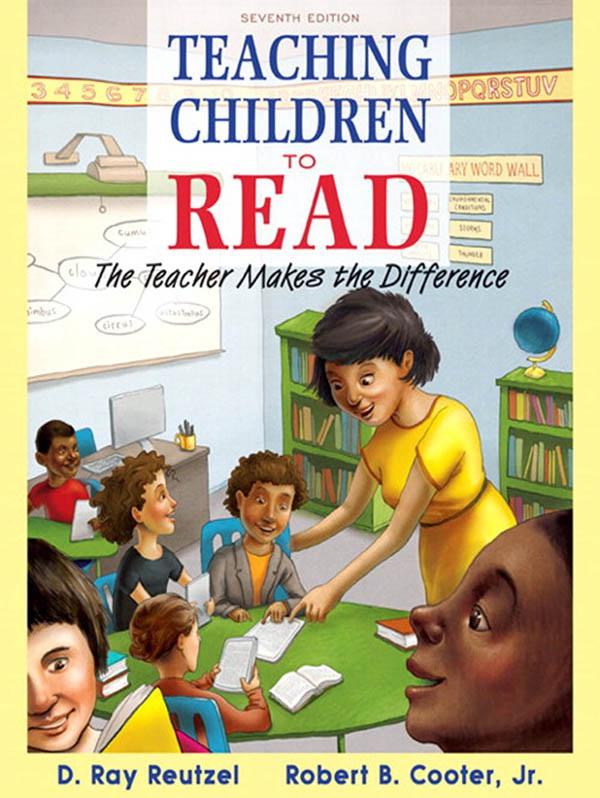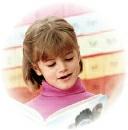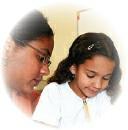About the Authors
D. Ray Reutzel is the Emma Eccles Jones Distinguished Professor and Endowed Chair of Early Literacy at Utah State University. He has taught kindergarten, first grade, third grade, and sixth grade. Dr. Reutzel is the author of more than 200 refereed research reports, articles, books, book chapters, and monographs published in The Elementary School Journal, Early Childhood Research Quarterly, Reading Research Quarterly, Journal of Literacy Research, Journal of Educational Research, Reading Psychology, Literacy Research and Instruction, Language Arts, Journal of Adolescent and Adult Literacy, and The Reading Teacher, among others. He has received more than $8 million in research and professional development funding from private, state, and federal agencies including the Institute of Education Sciences and the U.S. Department of Education.
Dr. Reutzel is the past editor of The Reading Teacher and Literacy Research and Instruction and current Executive Editor of The Journal of Educational Research. He is author or coauthor of several chapters published in the Handbook of Classroom Management, the Handbook of Research on Literacy and Diversity, and the Handbook of Reading Research (Vol IV) and editor of the Handbook of Research-Based Practice in Early Education
published by Guilford Press. Dr. Reutzel received the 1999 A.B. Herr Award from the College Reading Association for outstanding research and published contributions to reading education. Dr. Reutzel was given the John C. Manning Public School Service Award from the International Reading Association in May 2007 for his many years of working in schools with teachers and children. Dr. Reutzel has also served as past president of the College Reading Association/Association for Literacy Educators and Researchers and as a member of the board of directors of the International Reading Association from 2007 to 2010 Dr Reutzel was inducted as a member of the Reading Hall of Fame in 2011 and currently serves on the Board of Directors of the Literacy Research Association.

Robert B. Cooter, Jr., currently serves as Ursuline Endowed Professor and Dean of the Annsley Frazier Thornton School of Education at Bellarmine University in Louisville, Kentucky. Dr. Cooter served from 2006 to 2011 as editor of The Reading Teacher, the largest circulation literacy education journal worldwide. His research is focused on the improvement of literacy acquisition for children living in poverty In 2008 Dr Cooter received the A B Herr Award from the Association of Literacy Educators and Researchers for contributions to the field of literacy.
Earlier in his career Dr. Cooter served as an elementary classroom teacher and Title I reading specialist. In public school administration, he served as
the first “Reading Czar” (associate superintendent) for the Dallas Independent School District He was named Texas State Champion for Reading by the governor for development of the acclaimed Dallas Reading Plan for some 3,000 elementary school teachers. Dr. Cooter later designed and served as principal investigator of the Memphis Striving Readers Program, a $16 million middle school literacy research project funded by the U.S. Department of Education. In 2007 Dr. Cooter and colleagues J. Helen Perkins and Kathleen Spencer Cooter were recipients of the Urban Impact Award from the Council of Great City Schools for their work in high poverty schools.
Dr Cooter has authored or coauthored over 20 books in reading education and more than 60 journal articles. His books include the bestselling Strategies for Reading Assessment and Instruction (co-authored with D. Ray Reutzel) used at over 200 universities; The Flynt-Cooter Comprehensive Reading Inventory–2, a norm-referenced classroom reading assessment with English and Spanish versions; and Perspectives on Rescuing Urban Literacy Education: Spies, Saboteurs, and Saints. He is currently working on a new book with his wife and colleague, Professor Kathleen Cooter, entitled Urban Literacy Education: Helping City Kids in Regular and Special Education Classrooms.
Dr Cooter lives in Prospect, Kentucky, and enjoys family time on their houseboat, Our Last Child, with his bride, grandchildren, and golden retrievers. He sometimes appears in reunion concerts with The George Washington Bridge Band, a Nashville-based rock group he cofounded and toured with during the 1960s and 70s.
Pillar Four: Response to Intervention (RTI) 18
Pillar Five: Motivation and Engagement 20
Pillar Six: Technology and New Literacies 21
Pillar Seven: Family and Community Connections 21
Summary 23
Field and Classroom Applications 23
Recommended Resources 24
Part Two Essentials of Reading Development 25
2 Developing Children’s Oral Language to Support Literacy 26
Introduction 28
What Teachers Need to Know about Oral Language 29
What Is Language? 29
How Do Children Develop Oral Language? 38
The Developmental Stages of Oral Language Development 41
What Does Research Say about the Relationship Between Oral Language and Reading? 45
Effects of Poverty on Oral Language and Reading Development 45
English Learners and Vocabulary Development 46
Oral Language Is the “Great Predictor” 47
Common Core State Standards in Speaking and Listening 48
Teachers Can Make a Difference 49
Assessing Children’s Oral Language Development and Use 50
Teacher Rating of Oral Language and Literacy (TROLL) 51
IGDIs: Picture Naming Test 55
The Oral Language Acquisition Inventory (OLAI-2) 55
Test of Language Development (TOLD) 56
A “Rule of Thumb” for Determining Children’s Mean Length of Utterance (MLU) 57
Principles of Effective Oral Language Instruction 57
Promoting Oral Language Learning with Conversations 59
Oral Language Instructional Strategies 60
Instrumental Oral Language Instruction: Interviews 61
Regulatory Oral Language Instruction: Giving and Following Commands 62
Interactional Oral Language Instruction: Dialogic Reading 63
Personal Oral Language Instruction: “About Me!” 64
Heuristic Oral Language Instruction: Explaining, Arguing, and Persuading 65
Imaginative Oral Language Instruction: “Let’s Pretend” 68
Representational Oral Language: Instructions and Directions 68
Divertive Oral Language Instruction: “That’s Funny!” 69
Authoritative Oral Language Instruction: Now Hear This! 71
Perpetuating Oral Language Instruction: Remember This! 71
Tier 2 Adaptations 72
Resources and Programs Focused on Oral Language Development 73
English Learners: Important Considerations 74
Motivation and Engagement in Oral Language Development 75
Joint Productive Activity (JPA) 75
Technology and New Literacies for Oral Language Development 78
Electronic Talking Books (ETB) 78
Speech-to-Text (STT) and Text-to-Speech (TTS) Digital Applications 79
Conversation Applications for Computers and Tablets 79
Language Imitation Apps 80
How Family and Community Connections Encourage Oral
Language Development 80
Parent Read Alouds 80
Dialogic Reading for Parents with Limited English or Reading Ability 81
Summary 83
Field and Classroom Applications 84
Recommended Resources 85
3
Early Reading Instruction: Getting Started with the Essentials 86
Early Reading Concepts, Skills, and Strategies 88
What Is Early Reading and How Do Young Children Become Readers? 89
What Does Research Say about the Essentials of Early Reading Instruction? 91
Early Reading Classroom Assessment 93
Assessing Concepts about Print (CAP) 93
Assessing Phonemic Awareness 95
Assessing Letter-Name Knowledge 97
Early Reading Instruction 98
The Essentials of Early Reading Instruction 99
Concepts about Print Instruction 99
Strategies for Teaching Young Children Concepts about Print 101
Phonological and Phonemic Awareness Instruction 104
Letter-Name Instruction 111
Differentiating and Adapting Early Reading Instruction 114
Struggling Readers 114
Some Special Considerations for English Learners (ELs) 116
Motivation and Engagement of Early Readers 117
Read Aloud with Expository Books 117
Student Interests and Choice Matter . . . A Lot! 118
Technology and New Literacies for Early Readers 118
Family and Community Support for Early Readers 120
Summary 121
Field and Classroom Applications 122
Recommended Resources 122
4 Phonics and Word Recognition 123
What Teachers Need to Know to Teach Phonics 125
What Is Phonics? 125
Learning the Alphabetic Principle 126
Phonics for Teachers 127
Consonant Letters and Sounds 129
Vowel Letters and Sounds 131
Word Patterns 133
Onset and Rime 133
Body and Coda 135
Word Recognition: Teaching High-Frequency Sight Words 135
Structural Analysis: A Tool for Recognizing Multisyllabic Words 136
Putting It All Together: A Sequence for Phonics and Word
Identification Skill Instruction 138
Assessing and Monitoring Student Progress in Phonics 141
Letter-Naming Tests 141
High-Frequency Sight Word Reading Test 143
The Consortium on Reading Excellence (CORE) Phonics Survey 143
Running Records 145
Commercial Diagnostic Reading Tests 149
Effective Phonics Instruction 153
Five Approaches to Phonics Instruction 153
Effective Strategies for Teaching Phonics 154
Effective Strategies for Teaching High-Frequency Sight Words 160
Meeting the Needs of Diverse Learners in Phonics Instruction 162
Interactive Strategies for Struggling Readers 163
Helping Students with Dyslexia 164
English Learners 165
Motivation and Engagement Strategies for Teaching Phonics 166
Motivating Students with Games 166
Creating Nonsense Words 167
Using Technology and New Literacies to Enhance Phonics
Instruction 169
Fostering Phonics Development Outside the Classroom 169
Summary 171
Field and Classroom Applications 171
Recommended Resources 172
Introduction 175
Becoming
Measuring Students’ Reading Fluency 179
Assessing Accuracy and Reading Rate 180
Assessing Expressive Reading 182
Self-Assessment of Reading Fluency: Developing Meta-
Cognitive Awareness in Fluency 183
Characteristics of Effective Fluency Instruction 186
Fluency Instruction Time Allocation and Focus 188
Repeated Reading 188
Wide Oral Reading 190
Choral Reading 192
Partner or Paired Reading 192
Scaffolded Silent Reading (ScSR) 192
Differentiating Reading Fluency Instruction for Diverse Learners 193
Struggling Readers 194
English Learners 196
Engaging Strategies That Promote Fluency 196
Using Technology and New Literacies to Promote Reading Fluency 200
The Family Fluency Program 201
Summary 202
Field and Classroom Applications 203
6 Increasing Reading Vocabulary 204
What Does Research Tell Us about Vocabulary Learning? 207
How Do Students Acquire New Vocabulary? 208
Raising the Bar: Reading Vocabulary and the Common Core State Standards 208
Greater Use of Informational Texts 209
What Must Be Learned? The Four Types of Vocabulary 210
Levels of Vocabulary Learning 210
What Research Tells Us about Teaching Vocabulary 211
What Are the Most Important Words for Children to Know? 212
How Can Teachers Effectively Assess Students’ Vocabulary Knowledge? 213
Screening Assessments 213
Diagnostic Vocabulary Assessments 215
Progress-Monitoring Vocabulary Assessments 218
Instructional Strategies for Increasing Vocabulary Knowledge 218
Principles of Effective Vocabulary Instruction 218
Planning Vocabulary Instruction 219
Vocabulary Instruction Activities and Tools 220
Teaching Word Functions and Changes 226
Helping Students Learn Words Independently 228
Tier 2 Vocabulary Instruction 229
Areas to Consider for Tier 2 Vocabulary Interventions 229
Semantic Maps 230
Teaching Vocabulary 232
Planning Motivational Vocabulary Instruction 232
Using Technology and New Literacies to Enhance Vocabulary
Learning 233
Combining Video with Print Resources 233
Internet Resources 233
Digital Jumpstarts 234
Using Podcasts to Enhance Content Vocabulary Development 234
Family and Community Connections That Enhance Vocabulary
Learning 235
Reading Backpacks 235
Language Workshop: After-School Vocabulary-Building Activities 237
Summary 238
Field and Classroom Applications
Recommended Resources 239
7 Teaching Reading Comprehension 240
Introduction 242
What Is Reading Comprehension? 242
“Less Is More” in Comprehension Instruction 243
How Children Develop Reading Comprehension 244
What Does Research Say about Reading Comprehension Instruction? 247
A Roadmap for Reading Comprehension Instruction: Unifying the Common Core State Standards and Evidence-Based Research 247
Assessing Reading Comprehension 251
Assessing Factors Within the Reader Affecting Comprehension 251
Assessing Students’ Knowledge of Text Features and Structure 254
What Are the Most Effective Ways to Teach Reading
Comprehension? 260
The Reader 260
The Text 261
The Activity 268
The Situational Context 278
Meeting Students’ Diverse Needs for Comprehension Instruction 284
Alternative Strategy Instruction for Tiers 1 and 2: Comprehension Under Construction 285
Adapting Comprehension Instruction for English Learners 286
Children with Mild Learning Disabilities: The SLiCK Strategy 287
Helping Students with Asperger Syndrome Make Meaning 287
Improving Comprehension for Children with AS in Your Classroom 289
Motivation and Engagement Strategies for Teaching Reading Comprehension 289
Self-Determination Theory: Surveying Student Motivation 290
The Six Cs of Motivation 290
Affective Responses: Interpreting and Elaborating Meaning 292
Motivation for Children with Reading Disabilities: Priming and Praise 293
Focus on Comprehension 295
iPad Technology and Comprehension 295
Internet Reciprocal Teaching 295
Family and Community Connections That Enhance Students’
Reading Comprehension 298
Summer Reading Programs: Avoiding the Learning Melt 299
Summary 300
Field and Classroom Applications 301
Recommended Resources 301
8 Writing 303
Introduction 305
Where We Stand as a Nation 305
The Verdict Is In on Writing 306
What Teachers Need to Know about Teaching Writing 307
How Is Reading Related to Writing? 308
How Writing Develops 308
Unique Writing Patterns Used by Authors 315
Self-Regulated Strategies Development (SRSD) 317
Classroom Writing Assessment 317
What Are the Writing Skills to Be Learned at Each Grade Level (K–6)? 317
Common Core State Standards for Writing 318
How Do Teachers Assess Students’ Writing Abilities? 319
The Six-Trait Writing Model 324
Writing Instruction 328
Research on Writing Instruction 328
Providing Time for Students to Write 329
Understanding the Writing Process 330
Writing for Different Purposes 334
Writing with Voice: Prompts for Students 335
Implementation of Self-Regulated Strategies Development (SRSD) 336
Interactive Writing Procedures Help Learners Acquire New Writing Skills 338
Writing Aloud, Writing To: A Way of Structuring Your Teaching 338
The Writing Workshop 341
The Writing Center 344
The First Six Weeks of Writing Instruction 345
Using Tier 2 Writing Interventions 346
Quick Writes and POW + TREE 346
Helping English Learners Develop as Writers 347
Interactive Writing for English Learners 348
Motivating and Engaging Students to Write 349
Write-Talks 349
Schoolwide Photo Library: A Tool for Increasing Student Engagement in Writing 350
Technology and New Literacies That Promote Writing 351
Blogs 351
Wiki Writing 352
e-Reading and e-Responding 353
How Family and Community Connections Can Foster Writing 355
Friday Letters 355
Camp Imagination 355
Traveling Tales Backpack 357
Summary 357
Field and Classroom Applications 358
Recommended Resources 359
Part Three The Reading Teacher’s Toolbox 361
9 Evidence-Based Reading Programs and Tools 362
Introduction 364
What Are Core Reading Programs? 365
Organization of Core Reading Programs 365
Anatomy of Core Reading Programs 366
Beginning Reading Texts 370
Workbooks and Worksheets 373
Standards and Guidelines for Analyzing Workbook Tasks 374
Assessment 375
Student Data Management Systems 376
Assessing the Effectiveness of Core Reading Programs 376
Core Reading Programs 377
Houghton Mifflin: Invitations to Literacy 377
SRA/McGraw-Hill: Open Court Reading 378
Doors to Discovery 378
Macmillan/McGraw-Hill: Treasures Reading 379
Houghton-Mifflin Harcourt: Story Town 379
Success for All 379
Classwide Peer Tutoring 381
Little Books 381
Supplemental Reading Intervention Programs 382
Early Reading Supplemental Programs 382
Supplemental Programs for English Learners 385
How Can Core Reading Programs Be Adapted to Assist the Struggling Reader? 387
Programs and Standards Focused on Motivation and Engagement 387
The Student Reading Interest Survey (SRIS) 387
Accelerated Reader 389
Programs and Standards Focused on Technology and New Literacies 389
Assistive Technologies for Struggling Readers 391
How Can Teachers Help Parents and Communities Better
Understand Reading Programs and Standards? 391
Summary 392
Field and Classroom Applications 393
Recommended Resources 393
10 Assessment 394
Introduction 396
Principles and Purposes of Reading Assessment 396
Principles of Reading Assessment 397
Four Purposes of Reading Assessment 399
Where Do We Begin? A Classroom Teacher’s Perspective 400
Screening and Progress-Monitoring Assessments 401
Screening Assessments 401
Screening Assessments for English Learners 401
Progress Monitoring in the Reading Classroom 401
Kid Watching 401
Assessing Reading Interests and Self-Perception 403
Assessing Background Knowledge 405
Family Surveys of Reading Habits 406
Screening Checklists and Scales 407
Assessing Students’ Reading of Nonfiction Texts 408
Published Reading Tests for Screening and ProgressMonitoring Assessments 412
Curriculum-Based Measurement 413
Outcome Assessments 413
Dynamic Indicators of Basic Early Literacy Skills (DIBELS) 414
Texas Primary Reading Inventory (TPRI) 414
Diagnostic Assessments 415
Diagnosing Vocabulary Knowledge 415
Individual Diagnostic Reading Tests 415
Individually Administered Achievement Tests 416
Getting Organized: Profiling Your Class 416
Two Documents Needed for Profiling 417
Data-Driven Decision Making: IF–THEN Thinking 420
Summary 423
Field
Recommended


























